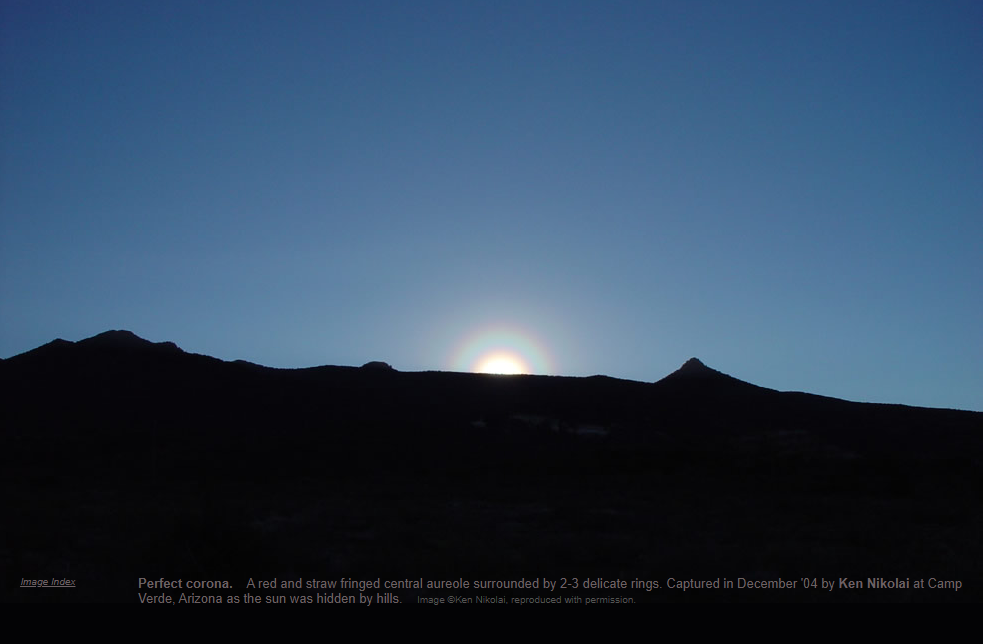Corona around the sun, Arizona
Corona around the Sun: A Spectacular Atmospheric Phenomenon in Arizona
When it comes to atmospheric optics, one of the most captivating sights is the corona around the sun. This breathtaking phenomenon occurs when sunlight interacts with water droplets or ice crystals in the atmosphere, creating a stunning display of colors and rings. In this article, we will delve into the intricacies of the corona around the sun, specifically in the picturesque state of Arizona.
Arizona's unique geographical features, such as its diverse landscapes and clear skies, make it an ideal location for observing atmospheric phenomena like the corona. The state's mountainous terrain and vast desert expanses provide a perfect backdrop for capturing the beauty of this natural spectacle. Photographers and skywatchers flock to Arizona to witness and document these awe-inspiring moments.
The Mechanics of a Corona
A corona is formed when sunlight passes through tiny water droplets or ice crystals suspended in the atmosphere. As light waves interact with these particles, they undergo a process called diffraction, causing the light to scatter in different directions. This scattering gives rise to the characteristic rings and colors of the corona.
The size of the water droplets or ice crystals determines the appearance of the corona. Smaller particles create more distinct rings, while larger ones produce a blurrier and less defined corona. The colors observed within the corona are a result of interference between light waves of different wavelengths. The varying distances traveled by these waves lead to constructive and destructive interference, resulting in a vibrant display of hues.
Ideal Conditions in Arizona
Arizona's arid climate and clear skies contribute to optimal conditions for observing and photographing the corona around the sun. The state's low humidity levels reduce the likelihood of precipitation, ensuring that water droplets remain scarce in the atmosphere. This scarcity creates an environment where the few droplets present are more likely to form smaller, well-defined corona rings.
Moreover, Arizona's high elevation locations, such as Camp Verde, offer unobstructed views of the horizon. With the sun hidden behind hills or mountains, the corona becomes more pronounced against the darkened backdrop. This setting provides photographers with an excellent opportunity to capture the intricate details and vibrant colors of the corona.
Capturing the Perfect Corona
Photographers like Ken Nikolai have successfully captured the beauty of the corona around the sun in Arizona. Nikolai's photograph from December 2004, taken in Camp Verde, showcases a perfect corona with a red and straw-fringed central aureole surrounded by two to three delicate rings. The image highlights the intricate patterns and colors that make the corona such a captivating sight.
To capture a stunning corona photograph, it is crucial to use proper equipment and techniques. A high-quality camera with manual settings allows for precise adjustments to capture the subtle details of the corona. Additionally, using a solar filter or shooting during sunrise or sunset can help reduce the intensity of sunlight, making it easier to capture the corona's delicate features.
The Wonders of Atmospheric Optics
The corona around the sun is just one example of the mesmerizing phenomena that can be observed through the study of atmospheric optics. From rainbows and halos to iridescent clouds and sundogs, the atmosphere presents an ever-changing canvas of colors and patterns. Understanding the science behind these phenomena adds a layer of appreciation to their beauty.
As we delve into the world of atmospheric optics, we gain insight into how light interacts with particles in the atmosphere. This knowledge not only enhances our understanding of natural phenomena but also contributes to scientific research and weather forecasting. By studying atmospheric optics, scientists can gain valuable insights into atmospheric composition, cloud formation, and climate patterns.
Conclusion
The corona around the sun is a mesmerizing atmospheric phenomenon that enchants observers in Arizona and beyond. With its picturesque landscapes and clear skies, Arizona provides an ideal setting for capturing the beauty of the corona. By understanding the mechanics behind this phenomenon and employing proper techniques, photographers can immortalize the intricate patterns and vibrant colors of the corona. Atmospheric optics, such as the corona, offer a glimpse into the wonders of our natural world and the fascinating interplay between light and atmospheric particles. So, next time you find yourself in Arizona, keep an eye on the sky and prepare to be captivated by the ethereal beauty of the corona around the sun.

Perfect corona. A red and straw fringed central aureole surrounded by 2-3 delicate rings. Captured in December '04 by Ken Nikolai at Camp Verde, Arizona as the sun was hidden by hills. Image ©Ken Nikolai, reproduced with permission.
Note: this article has been automatically converted from the old site and may not appear as intended. You can find the original article here.
Reference Atmospheric Optics
If you use any of the definitions, information, or data presented on Atmospheric Optics, please copy the link or reference below to properly credit us as the reference source. Thank you!
-
<a href="https://atoptics.co.uk/blog/corona-around-the-sun-arizona/">Corona around the sun, Arizona</a>
-
"Corona around the sun, Arizona". Atmospheric Optics. Accessed on November 26, 2024. https://atoptics.co.uk/blog/corona-around-the-sun-arizona/.
-
"Corona around the sun, Arizona". Atmospheric Optics, https://atoptics.co.uk/blog/corona-around-the-sun-arizona/. Accessed 26 November, 2024
-
Corona around the sun, Arizona. Atmospheric Optics. Retrieved from https://atoptics.co.uk/blog/corona-around-the-sun-arizona/.